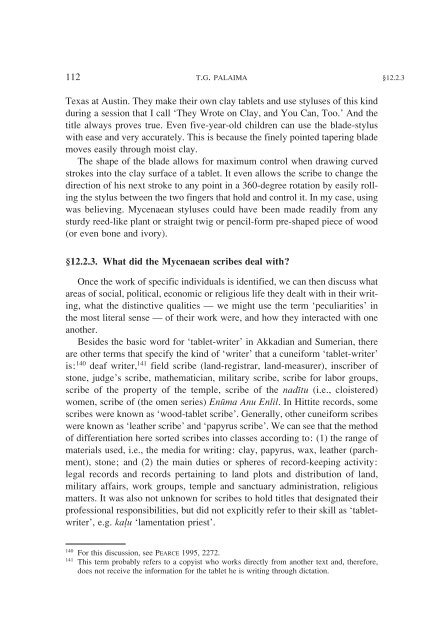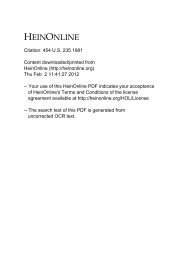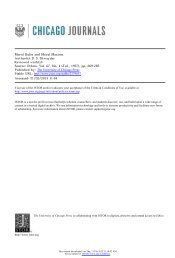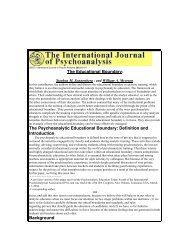A Companion to Linear B - The University of Texas at Austin
A Companion to Linear B - The University of Texas at Austin
A Companion to Linear B - The University of Texas at Austin
Create successful ePaper yourself
Turn your PDF publications into a flip-book with our unique Google optimized e-Paper software.
112 T.G. PALAIMA §12.2.3<br />
<strong>Texas</strong> <strong>at</strong> <strong>Austin</strong>. <strong>The</strong>y make their own clay tablets and use styluses <strong>of</strong> this kind<br />
during a session th<strong>at</strong> I call ‘<strong>The</strong>y Wrote on Clay, and You Can, Too.’ And the<br />
title always proves true. Even five-year-old children can use the blade-stylus<br />
with ease and very accur<strong>at</strong>ely. This is because the finely pointed tapering blade<br />
moves easily through moist clay.<br />
<strong>The</strong> shape <strong>of</strong> the blade allows for maximum control when drawing curved<br />
strokes in<strong>to</strong> the clay surface <strong>of</strong> a tablet. It even allows the scribe <strong>to</strong> change the<br />
direction <strong>of</strong> his next stroke <strong>to</strong> any point in a 360-degree rot<strong>at</strong>ion by easily rolling<br />
the stylus between the two fingers th<strong>at</strong> hold and control it. In my case, using<br />
was believing. Mycenaean styluses could have been made readily from any<br />
sturdy reed-like plant or straight twig or pencil-form pre-shaped piece <strong>of</strong> wood<br />
(or even bone and ivory).<br />
§12.2.3. Wh<strong>at</strong> did the Mycenaean scribes deal with?<br />
Once the work <strong>of</strong> specific individuals is identified, we can then discuss wh<strong>at</strong><br />
areas <strong>of</strong> social, political, economic or religious life they dealt with in their writing,<br />
wh<strong>at</strong> the distinctive qualities — we might use the term ‘peculiarities’ in<br />
the most literal sense — <strong>of</strong> their work were, and how they interacted with one<br />
another.<br />
Besides the basic word for ‘tablet-writer’ in Akkadian and Sumerian, there<br />
are other terms th<strong>at</strong> specify the kind <strong>of</strong> ‘writer’ th<strong>at</strong> a cuneiform ‘tablet-writer’<br />
is: 140 deaf writer, 141 field scribe (land-registrar, land-measurer), inscriber <strong>of</strong><br />
s<strong>to</strong>ne, judge’s scribe, m<strong>at</strong>hem<strong>at</strong>ician, military scribe, scribe for labor groups,<br />
scribe <strong>of</strong> the property <strong>of</strong> the temple, scribe <strong>of</strong> the naditu (i.e., cloistered)<br />
women, scribe <strong>of</strong> (the omen series) Enuma Anu Enlil. In Hittite records, some<br />
scribes were known as ‘wood-tablet scribe’. Generally, other cuneiform scribes<br />
were known as ‘le<strong>at</strong>her scribe’ and ‘papyrus scribe’. We can see th<strong>at</strong> the method<br />
<strong>of</strong> differenti<strong>at</strong>ion here sorted scribes in<strong>to</strong> classes according <strong>to</strong>: (1) the range <strong>of</strong><br />
m<strong>at</strong>erials used, i.e., the media for writing: clay, papyrus, wax, le<strong>at</strong>her (parchment),<br />
s<strong>to</strong>ne; and (2) the main duties or spheres <strong>of</strong> record-keeping activity:<br />
legal records and records pertaining <strong>to</strong> land plots and distribution <strong>of</strong> land,<br />
military affairs, work groups, temple and sanctuary administr<strong>at</strong>ion, religious<br />
m<strong>at</strong>ters. It was also not unknown for scribes <strong>to</strong> hold titles th<strong>at</strong> design<strong>at</strong>ed their<br />
pr<strong>of</strong>essional responsibilities, but did not explicitly refer <strong>to</strong> their skill as ‘tabletwriter’,<br />
e.g. ka¬u ‘lament<strong>at</strong>ion priest’.<br />
140 For this discussion, see PEARCE 1995, 2272.<br />
141 This term probably refers <strong>to</strong> a copyist who works directly from another text and, therefore,<br />
does not receive the inform<strong>at</strong>ion for the tablet he is writing through dict<strong>at</strong>ion.

















